|
|
 |
|
Calanoida ( Order ) |
|
|
|
Metridinidae ( Family ) |
|
|
|
Metridia ( Genus ) |
|
|
| |
Metridia venusta Giesbrecht, 1889 (F,M) | |
| | | | | | | Syn.: | Metridia normanni (M) Giesbrecht, 1892 (p.340, 773, figs.M); Giesbrecht & Schmeil, 1898 (p.107, Rem. F); Wolfenden, 1904 (p.125); 1911 (p.287); Wilson, 1936 c (p.91);
no Metridia venusta : I.C. Thompson, 1903 a (p.24, fig. juv.M) | | | | Ref.: | | | Giesbrecht, 1892 (p.340, 346, Descr.F, figs.F); Giesbrecht & Schmeil, 1898 (p.107); Farran, 1908 b (p.60); A. Scott, 1909 (p.122, figs.F,M, Rem.); Lysholm & Nordgaard, 1921 (p.23); Sars, 1925 (p.200, figs.F,M); Farran, 1926 (p.271); Sewell, 1932 (p.263); Rose, 1933 a (p.178, figs.F,M); Farran, 1936 a (p.110); Tanaka, 1937 (p.266, figs. juv.F, Rem.); Jespersen, 1940 (p.46); Lysholm & al., 1945 (p.32); Farran, 1948 c (n°14, p.3, figs.F); Vervoort, 1957 (p.121, Rem.); Grice, 1962 (p.215, figs.F,M); Tanaka, 1963 (p.17, figs.F,M); Paiva, 1963 (p.53, figs.F); Owre & Foyo, 1967 (p.70, figs.F,M); Bradford, 1970 a (p.357, fig.M); Roe, 1984 (p.358); Chihara & Murano, 1997 (p.837, tab.6); Bradford-Grieve & al., 1999 (p.884, 948, figs.F,M); Bradford-Grieve,1999 b (p.117, figs.F,M, Rem., figs.178, 192); Vives & Shmeleva, 2007 (p.367, figs.F,M, Rem.) |  issued from : Tanaka O. in Publs Seto Mar. Biol. Lab., 1963, XI (1). [p.17, Fig.155]. Female (juvenile): a, P5. Male: b, last thoracic segment and urosome (dorsal); c, P5.
|
 isued from : J.M. Bradford-Grieve in The Marine Fauna of New Zealand: Pelagic Calanoid Copepoda. National Institute of Water and Atmospheric Research (NIWA). NIWA Biodiversity Memoir, 111, 1999. [p.118, Fig.79]. Female (30°45'S, 173°16'E): A, urosome (dorsal); B, P5. Male: C, urosome (dorsal); D, P5 (L = left leg; R = right leg). Female characteristics: Forehead narrows anreriorly in dorsal view; - Posterior metasomal corners angular. ) Caudal rami asymmetrical, left ramus longest. - A1 shorter than the body. - P5 with 1 free segment, asymmetrical, shorter on right, carrying 4 setae, 3 of them apical (median one longest), and 1 external. Male characteristics: P5 asymmetrical, 3-segmented; on right segment 1 with an inner tubercle and 1 distolateral seta; segment 2 with 2 distal setae, 1 internal, 1 external; segment 3 elongate and curved with 4 flutes on inner border; left leg is shorter with last 2 segments hairy on inner border and with some simple setae. On a Southwest Pacific male the right P5 has a 3-segmented exopod with segment 2 with an outer edge spine and inner edge pointed projection; right basipod 2 with an inner-toothed process and with an outer distal plumose seta similar to those on left basipod 2 and exopod segments 1 and 2+3.
|
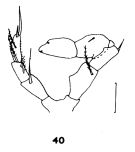 issued from : J.M. Bradford in N.Z. Jl Mar. Freshw. Res., 1970, 4 (4). [p.357, Fig;40 ]. Male (off Kaikoura, New Zealand): 40, P5. Scale bar represent 0.1 mm.
|
 Issued from : G.O. Sars in Résult. Camp. Scient. Prince Albert I, 69, pls.1-127 (1924). [Pl.LIV, figs.12-16]. Female: 12, habitus (dorsal); 13, proximal portion of A1; 14, 1st endopodal segment of P2 (and adjacent segments); 15, P5. Male: 16, P5.
|
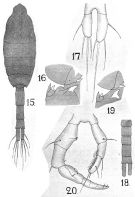 issued from : A. Scott in Siboga-Expedition, 1909, XIX a. [Plate XXXVII, Figs.15-20]. Female (from Indonesia-Malaysia): 15, habitus (dorsal); 16, P2 (hooks on basal segment of endopodite); 17, P5. Male: 18, habitus (dorsal); 19, P2 (hooks on basal segment of endopodite); 20, P5.
|
 issued from : G.D. Grice in Fish. Bull. Fish and Wildl. Ser., 1962, 61. [p.214, Pl.20, Figs.13-17]. Female (from 00°16'N, 140°12'W): 13, habitus (dorsal); 14, P2 (3rd exopodal segment omitted); 15, P5. Male: 16, urosome (dorsal); 17, P5. Nota: In both sexes the left caudal ramus is longer than the right one.
|
 Issued from : W. Giesbrecht in Systematik und Faunistik der Pelagischen Copepoden des Golfes von Neapel und der angrenzenden Meeres-Abschnitte. – Fauna Flora Golf. Neapel, 1892, 19 , Atlas von 54 Tafeln. [Taf.33, Figs.7, 29]. Female: 7, A1 (proximal segments); 29, habitus (dorsal).
|
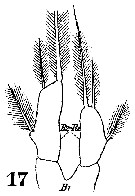 Issued from : W. Giesbrecht in Systematik und Faunistik der Pelagischen Copepoden des Golfes von Neapel und der angrenzenden Meeres-Abschnitte. – Fauna Flora Golf. Neapel, 1892, 19 , Atlas von 54 Tafeln. [Taf.33, Fig.17]. Female: 17, P5.
|
 Issued from : W. Giesbrecht in Systematik und Faunistik der Pelagischen Copepoden des Golfes von Neapel und der angrenzenden Meeres-Abschnitte. – Fauna Flora Golf. Neapel, 1892, 19 , Atlas von 54 Tafeln. [Taf.33, Figs.1, 6]. As Metridia normani. Male: 1, A1 (ventral view); 6, right A1 (proximal segments).
|
 Issued from : W. Giesbrecht in Systematik und Faunistik der Pelagischen Copepoden des Golfes von Neapel und der angrenzenden Meeres-Abschnitte. – Fauna Flora Golf. Neapel, 1892, 19 , Atlas von 54 Tafeln. [Taf.33, Figs.24, 25]. As Metridia normani. Male: 24, P5 (posterior view); 25, exopod of P3 (inner setae missing).
|
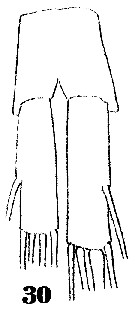 Issued from : W. Giesbrecht in Systematik und Faunistik der Pelagischen Copepoden des Golfes von Neapel und der angrenzenden Meeres-Abschnitte. – Fauna Flora Golf. Neapel, 1892, 19 , Atlas von 54 Tafeln. [Taf.33, Fig.30]. As Metridia normani. Male: 30, caudal rami.
|
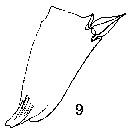 Issued from : W. Giesbrecht in Systematik und Faunistik der Pelagischen Copepoden des Golfes von Neapel und der angrenzenden Meeres-Abschnitte. - Fauna Flora Golf. Neapel, 1892, 19 , Atlas von 54 Tafeln. [Taf.32, Fig.9]. Female: 9, exopodal segment 1 of P2 (anterior view).
|
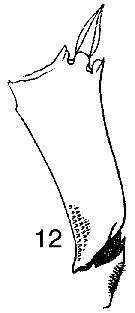 Issued from : W. Giesbrecht in Systematik und Faunistik der Pelagischen Copepoden des Golfes von Neapel und der angrenzenden Meeres-Abschnitte. - Fauna Flora Golf. Neapel, 1892, 19 , Atlas von 54 Tafeln. [Taf.32, Fig.12]. As Metridia normani. Male: 12, exopodal segment of P2 (anterior view).
|
 Issued from : H.B. Owre & M. Foyo in Fauna Caribaea, 1, Crustacea, 1: Copepoda. Copepods of the Florida Current, 1967. [p.11, Fig.8]. Female: 8, P5. Bsp 1 = basipodite 1 ( = Coxa)
| | | | | Compl. Ref.: | | | Cleve, 1904 a (p.192); Pearson, 1906 (p.23, Rem.); Sewell, 1948 (p.503, 519, 547, 557); C.B. Wilson, 1950 (p.265); Grice, 1963 a (p.495); De Decker & Mombeck, 1964 (p.13); Grice & Hulsemann, 1965 (p.224); 1967 (p.17); Furuhashi, 1966 a (p.295, vertical distribution in Oyashio/Kuroshio transitional area, Table 8, 9, 10); De Decker, 1968 (p.45); Park, 1970 (p.477); Roe, 1972 (p.277, tabl.1, tabl.2); 1972 b (p.542); Björnberg, 1973 (p.338, 387); Vives & al., 1975 (p.46, tab.II, III, XII); Deevey & Brooks, 1977 (p.256, tab.2, Station "S"); Pipe & Coombs, 1980 (p.223, figs. 1, 2, table 1, vertical distribution); Vives, 1982 (p.293); Rudyakov, 1982 (p.208, Table 2); Longhurst, 1985 (tab.2); Brenning, 1985 a (p.28, Table 2); Wishner & Allison, 1986 (tab.2); Lozano Soldevilla & al., 1988 (p.59); Heinrich, 1990 (p.18); Ashjian & Wishner, 1993 (p.483, abundance, species group distributions); Shih & Young, 1995 (p.70); Lapernat, 2000 (tabl. 3, 4); Razouls & al., 2000 (p.343, Appendix); Holmes, 2001 (p.19, Rem.); Shimode & al., 2005 (p.113 + poster); Wishner & al., 2008 (p.163, Table 2, fig.8, oxycline); Gaard & al., 2008 (p.59, Table 1, N Mid-Atlantic Ridge); Park & Ferrari, 2009 (p.143, Table 5, Appendix 1, biogeography); Medellin-Mora & Navas S., 2010 (p.265, Tab. 2); Hirai & al., 2013 (p.1, Table I, molecular marker); El Arraj & al., 2017 (p.272, table 2); Hirai & al., 2020 (p.1, Fig. 5: cluster analysis (OTU), spatial distribution). | | | | NZ: | 15 | | |
|
Distribution map of Metridia venusta by geographical zones
|
| | | | | | | | | | | | | | |  Issued from : P.-E. Lapernat in DEA Océanogr. Biol., Univ. P. & M. Curie, Paris VI. July 5, 2000. [Fig.9 f]. Issued from : P.-E. Lapernat in DEA Océanogr. Biol., Univ. P. & M. Curie, Paris VI. July 5, 2000. [Fig.9 f].
Verical distribution of Metridia venusta at an eutrophic site (off Mauritanian coast: 20°32 'N, 18°36' W) in females (F) and males (M) (ind. per m3) in the day (white circle) and night (black circle).
Nota: Sampling in the water column 0-1000 m, one during the day and another during the night with BIONESS multiple-net: 0-75; 75-150; 150-250; 250-350; 350-450; 450-550; 550-700; 700-850; 850-965 m. in May-June 1992. |
| | | | Loc: | | | sub-Antarct. (Indian), South Africa (E & W), Cape Verde Is., off Mauritania - NW Cape Verde, off Morocco-Mauritania, Canary Is., off Madeira, Azores, off Portugal, Ibero-moroccan Bay, off W Cape Finisterre, Bay of Biscay, W Ireland, Iceland, Wyville Thomson Ridge (60°N), Faroe Is., North Sea, Barbados Is., Caribbean Sea, Caribbean Colombia, G. of Mexico, Florida, Sargasso Sea, off Bermuda: Station ‘S’(32°10’N, 64°30’W), off Cape Hatteras, Indian Ocean, Arabian Sea, Indonesia-Malaysia, Philippines, China Seas (East China Sea, South China Sea), Japan (Izu region), SE Japan, Kuroshio zone, Australia (Great Barrier), New Zealand (Kaikoura, SE South Island, off N North Island), Tasman Sea, Kermadec Is., S Tasmania, Pacif. (equatorial), off Galapagos, off W Guatemala, W Ecuador, off NE Easter Is., Pacif. (SE tropical), Chile (N & S) | | | | N: | 63 | | | | Lg.: | | | (1) F: 2,9; (5) F: 3,1; M: 2,8; (26) M: 2,82; (34) F: 3,05-2,65; (38) F: 2,9-2,82; M: 2,64-2,59; (46) M: 2,65; (73) F: 3,15-2,72; (101) M: 2,82; (199) F: 3,04-2,66; M: 2,66-2,43; (313) M: 2,8; 2,6; (909) F: 2,7-3; M: 2,6; {F: 2,65-3,15; M: 2,43-2,82}
The mean female size is 2.891 mm (n = 12; SD = 0.1790), and the mean male size is 2.674 mm (n = 11; SD = 0.1240). The size ratio (male : female) is 0.91 (n = 4; SD = 0.6090). | | | | Rem.: | meso-bathypelagic. Sargasso Sea: 500-2000 m (Deevey & Brooks, 1977, Station "S") . 204-457 m at Station S 2 in South Bösö (E middle Japan). 530-580 m (Pipe & Coombs, 1980, in Arctic) | | | Last update : 25/10/2022 | |
|
|
 Any use of this site for a publication will be mentioned with the following reference : Any use of this site for a publication will be mentioned with the following reference :
Razouls C., Desreumaux N., Kouwenberg J. and de Bovée F., 2005-2025. - Biodiversity of Marine Planktonic Copepods (morphology, geographical distribution and biological data). Sorbonne University, CNRS. Available at http://copepodes.obs-banyuls.fr/en [Accessed October 22, 2025] © copyright 2005-2025 Sorbonne University, CNRS
|
|
 |
 |

















